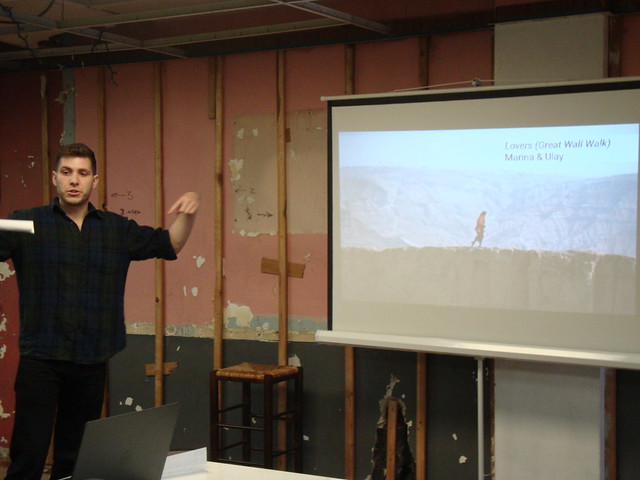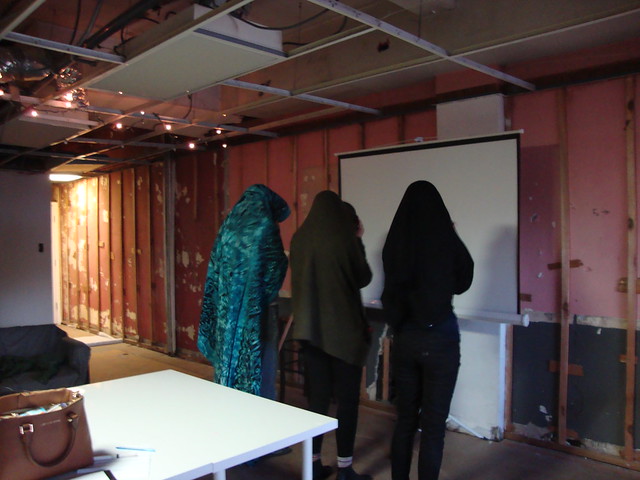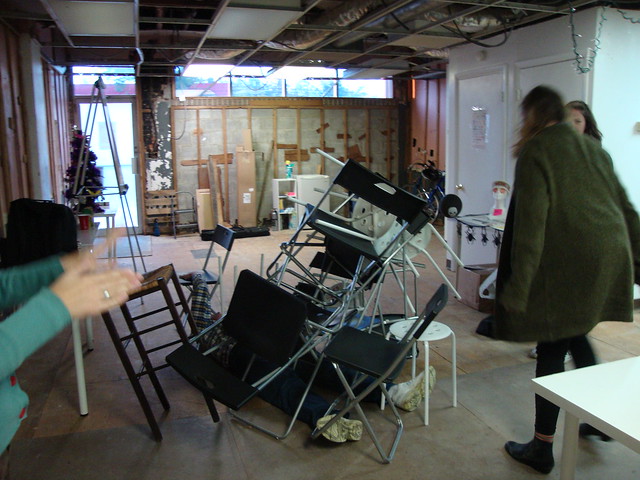Class Report
Let’s Get Weird: Intro to Performance Art

Teacher: DeLesslin “Roo” George-Warren, left, New York City-based performance artist
Location: KCDC Pop-Up Learning Space
Date: Nov. 8, 2015
See more photos of this class on Flickr!
From its roots in Greco-Roman theater and the minstrels of Old England, to the influences of the Italian Futurists, Surrealists, and Dadaists, performance art has evolved over the past few centuries in ways that test the limits of imagination. The art form challenges the artist as well as the audience to engage in the creation, execution, and the implementation — or sometimes non-implementation — of the work itself.
In November’s workshop, instructor and New York City-based performance artist DeLesslin “Roo” George-Warren gave us a taste of craft’s history and the opportunity to create our own interactive pieces. Turns out, performance art encompasses a rich variety of art forms. It can use all of the five senses; push the boundaries of what it means to be human and have a conscience; serve as a feminist statement or a political criticism; and strain human physical and emotional endurance. It can be sensual, comic, choreographed, or spontaneous; it can be a means to provoke and entertain, or viewed for simply its aesthetic value.
Before Roo shared with us some of the most important works from the past century, as well as his personal favorites, he had us play a round of Exquisite Corpse, a freeform poetry exercise based in Surrealism. We had fun reading and discussing.
While you can trace the beginnings of modern performance art to writers, musicians, and artists of the 18th and 19th centuries, it wasn’t until the 1960s and ‘70s that it gained widespread popularity and began changing the way people think about art, its sources, various media and presentation, and, ultimately, its message to the audience.

Three students get weird wearing cloaks.
Roo highlighted some of the most subversive artists and works from the ‘60s onward, including Allan Kaprow; the erotic, satirical body art of Carolee Schneemann; Chris Burden; Yoko Ono’s anti-consumerist work with Fluxus’ instruction-based art (never meant to be performed!); the electronic music of Laurie Anderson, whose song “O Superman” reached No. 2 on the UK charts in the ‘80s; and the ‘90s aggressive activist art of Zhang Huan, Ai Weiwei, and Pussy Riot. He closed with Tilda Swinton’s “The Maybe,” at the MoMA; Marina Abramović’s “Rhythm” series, in which she collaborated with the audience in an original and shocking way; “The Great Wall Walk,” in which Abramović and her partner, Ulay, met at the middle of the Great Wall after trekking from either end; and Narcissister’s unconventional performance on “America’s Got Talent.”

A student gets weird with chairs.
As a part of the workshop, Roo invited us to come up with our own ephemeral pieces, with no limitations except to not harm ourselves or damage property. He developed one himself that featured a roll of plastic, a pushbroom, and brilliant humming vocals to signal the end of the performance.

Roo gets weird with a pushbroom.
Carolyn Harf volunteers at the Washington English Center and is a student of Oriental Medicine and Public Health at Maryland University of Integrative Health. She loves teaching, yoga, and painting.
